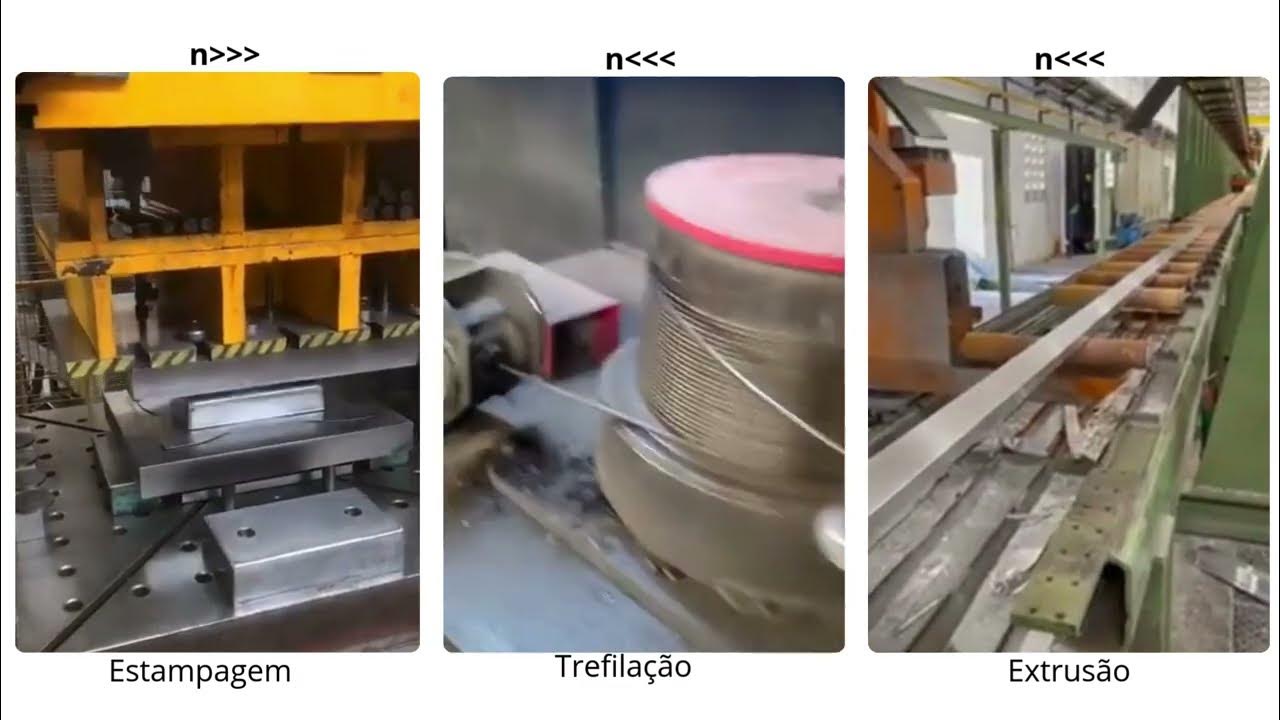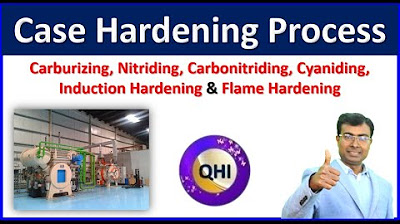Pitch sobre Encruamento
Summary
TLDRThis video script explains the concept of 'encruamento' (work hardening) in metallurgy, where metals become stronger as they are plastically deformed, typically through cold working processes. The script covers how dislocations in the crystal structure increase with deformation, leading to higher resistance to further plastic deformation. It also discusses the effects of encruamento, including increased tensile strength and reduced ductility. Various factors like crystallography, dislocation movement, and the impact of annealing (a heat treatment process) are also explored. Practical applications, such as wire drawing, are highlighted as examples of how work hardening is applied in manufacturing.
Takeaways
- 😀 Encruamento (work hardening) is a phenomenon where a metal becomes more resistant as it is plastically deformed, also known as cold working.
- 😀 It occurs when a metal is subjected to stress beyond its yield point, leading to permanent changes in the material's structure.
- 😀 As plastic deformation happens, dislocations (imperfections) in the crystal lattice are generated, which resist further deformation.
- 😀 The more a material is deformed, the more dislocations are created, which increases resistance to movement and, consequently, material strength.
- 😀 Work hardening increases the tensile strength and yield strength of the material, making it stiffer and harder to deform further.
- 😀 Ductility decreases as work hardening occurs, because the accumulation of dislocations reduces the material’s ability to deform plastically.
- 😀 The degree of work hardening can be described by the Luding equation, which relates the coefficient of work hardening to the material's deformation resistance.
- 😀 Hexagonal close-packed (hcp) metals exhibit lower work hardening rates due to fewer slip systems in their crystal structure.
- 😀 Annealing, a heat treatment process, can reverse the effects of work hardening by allowing the metal to recrystallize and reduce internal stresses.
- 😀 The process of cold working, such as wire drawing, increases hardness and strength but requires careful attention to avoid cracking due to excessive stress.
Q & A
What is work hardening (encruamento)?
-Work hardening, or encruamento, is a phenomenon where a metal becomes more resistant as it undergoes plastic deformation. It is also known as cold working, as the deformation occurs at temperatures lower than the metal's melting point.
How does plastic deformation contribute to work hardening?
-Plastic deformation involves the movement of atomic layers over each other, creating dislocations or imperfections in the crystal lattice. These dislocations hinder the movement of other layers, causing the material to become stronger and harder as the deformation increases.
What role do dislocations play in work hardening?
-Dislocations, or imperfections in the crystal lattice, play a key role in work hardening by impeding the movement of atomic layers. As deformation increases, more dislocations are created, which make it harder for the material to deform further, thus increasing its strength.
What happens to the metal’s structure during work hardening?
-During work hardening, the metal's crystal structure becomes increasingly distorted as more dislocations accumulate. This increase in dislocation density makes it more difficult for the metal to deform, raising its strength and reducing its ductility.
How does work hardening affect a material's mechanical properties?
-Work hardening increases a material's yield strength and tensile strength, making it more rigid and less prone to further deformation. However, it also reduces ductility, making the material less able to deform without breaking.
What is the relationship between work hardening and yield strength?
-As work hardening progresses, the yield strength of a material increases. This means that the material requires a higher applied stress to begin deforming plastically, making it stronger and more resistant to further deformation.
What is the effect of cold working on the material's ductility?
-Cold working reduces the ductility of a material by increasing the number of dislocations and defects in the crystal structure. This makes it harder for the material to undergo further plastic deformation, resulting in lower ductility.
How does the Luding equation relate to work hardening?
-The Luding equation relates work hardening to the material's flow curve. It shows that the higher the work hardening coefficient (N), the harder it is for the material to deform, and the steeper the slope of the yield curve. A lower N indicates easier deformation and a less steep slope.
Why do metals with a hexagonal close-packed (HCP) structure have lower work hardening rates?
-Metals with an HCP structure have fewer slip systems, or directions in which dislocations can move. As a result, the dislocation movement is more restricted, leading to a lower rate of work hardening compared to metals with a face-centered cubic (FCC) structure.
What is annealing, and how does it relate to work hardening?
-Annealing is a thermal treatment used to reverse the effects of work hardening. It involves heating the material to a specific temperature to allow the formation of new grains free from internal stresses, which restores ductility and reduces hardness.
Outlines

This section is available to paid users only. Please upgrade to access this part.
Upgrade NowMindmap

This section is available to paid users only. Please upgrade to access this part.
Upgrade NowKeywords

This section is available to paid users only. Please upgrade to access this part.
Upgrade NowHighlights

This section is available to paid users only. Please upgrade to access this part.
Upgrade NowTranscripts

This section is available to paid users only. Please upgrade to access this part.
Upgrade NowBrowse More Related Video

Pitch sobre Curva de Escoamento

Materiais e Processos de Fabricação para Engenharia de Produção - Processos de Laminação

Aluminium and the Age of Flight - Metal: How It Works - BBC Four

Case Hardening and 6 Types of Case Hardening || Heat Treatment Process

Heat treatment of metals | Types. Process, Applications

Surface Hardening Process | A Complete Guide To Its Types and Techniques.
5.0 / 5 (0 votes)